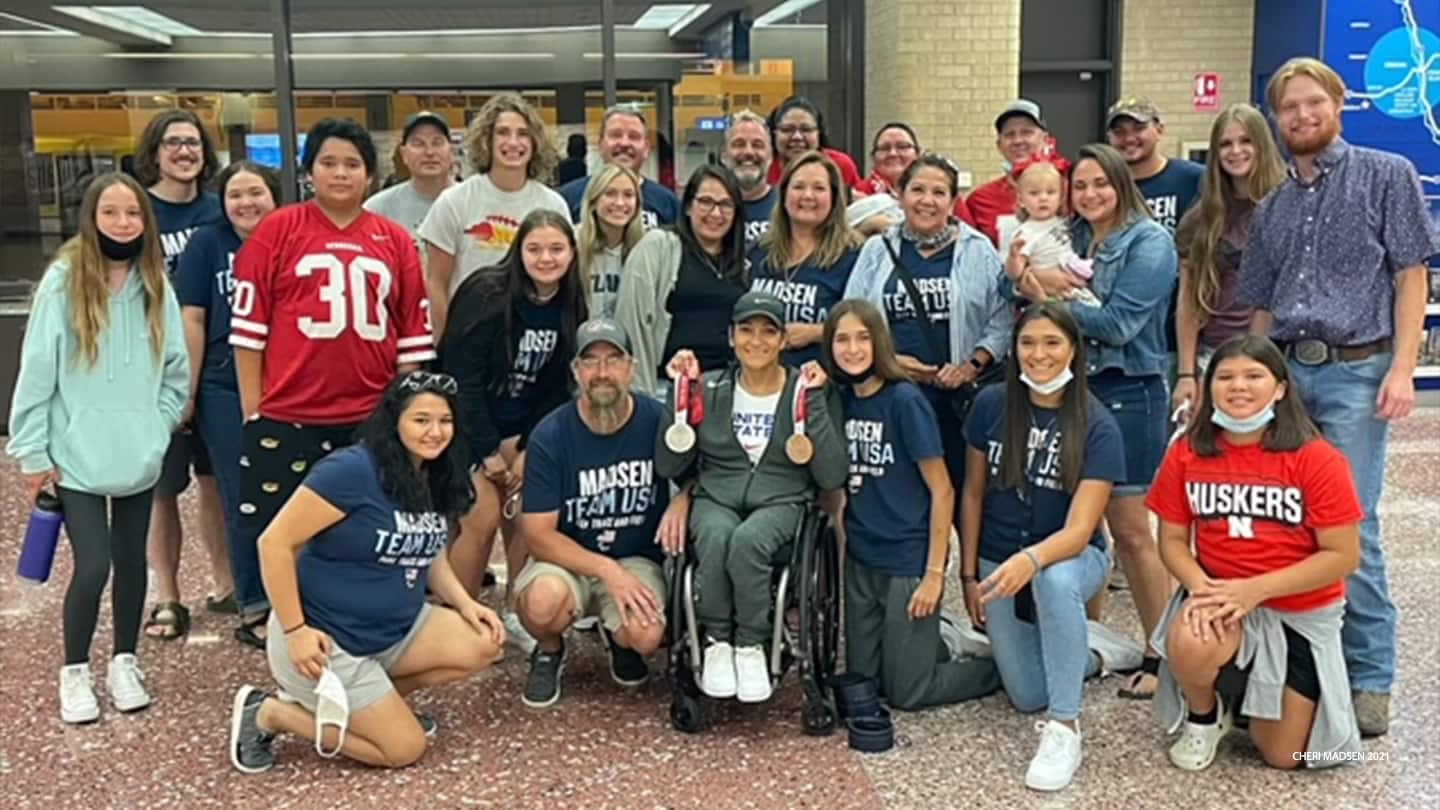
Paralympian Cheri Madsen Shares How Her Family’s American Indian Heritage Shaped Her Personal Journey
by Lisa Costantini

Cheri Madsen poses on the podium at the medal ceremony for the women's 100-meter T54 at the Paralympic Games Tokyo 2020 on Sept. 1, 2021 in Tokyo.
When Paralympian Cheri Madsen first started as a wheelchair racer at 15 years old, she knew nothing about the sport. And it was her American Indian family who helped her with the funds so she could compete.
“My grandmother [who is Omaha Indian] and my family went to the reservation to see if the family could help. They started a matching fund for me; they would match it every time I raised money. And that was how I started my career, being able to participate in events. They’ve been huge supporters,” she exclaimed.
After competing at the Paralympic Games Tokyo 2020 at her fourth Games — where she earned two medals and officially called it quits — they were there to support her at the end, too.
“They came to the airport when I got back from Tokyo and surprised me,” she said about her Native American family members. “It was cool.”
Grandma Moves In #
When the 45-year-old was four years old, she woke up from a nap and found herself unable to walk. She was diagnosed with “an unknown virus” that left her paralyzed from the waist down. Soon after, “my [maternal] grandma moved in with my mom to help raise us,” Madsen said about her and her five siblings.
Her grandmother moved off the reservation when she was 17, as she was of the generation that “wanted to leave to try to make a better life for her kids,” the 10-time medalist said.
The two spent a lot of time together growing up, and Madsen learned a lot about her heritage from her grandma. “She took care of us: she cooked, cleaned, braided my hair. We were really close.” Eventually, when Madsen fell in love and got married, her grandma moved in with her and her new husband.
Keeping the Family Heritage Alive #
Having lost her grandma years ago and more recently her mom in November 2020, Madsen tries to keep her heritage alive by sharing the stories with her 18- and 15-year-old daughters.
As a family, they have gone back to visit the reservation and taken part in powwows, a celebration of American Indian culture where tribal communities gather to sing and dance as a way to honor the traditions of their ancestors.
“To be an Omaha Native American, I feel honored to represent them,” the wheelchair racer said. “I always love going back and speaking with the youth.”
Madsen said she feels a responsibility to the younger Native American generation to share her story and her journey.
By doing speaking engagements, she said she hopes to lead by example that there are a lot of possibilities available to them. “You can do anything if you set your mind to it.”

Cheri Madsen poses with her family after returning home from the Paralympic Games Tokyo 2020 on Sept. 4, 2021.
Her Heritage and Her Athletic Career #
Growing up, Madsen was the only Native American wheelchair racer coming up through the ranks. Other than indigenous athletes, she didn’t see herself reflected in many of her competitors.
The lack of diversity resulted in one racist moment in particular in her sporting career. “I remember being on a bus at an international track meet with athletes from other countries who knew I was Native American. And they started making these offensive noises. I was taken aback by it,” Madsen said. “I didn’t understand why they thought it was funny — and it was a little wake-up call.”
That experience might have been more than 20 years ago, but it has stuck with her.
“Now, there’s more media exposure,” she said about the Games and the desire to highlight Native American athletes and stories. And it’s not only at the Olympic and Paralympic level where they’re getting exposure. “It’s also the high school and college level where they’re trying to promote Native American athletes.”
The Tribal Adaptive Organization recently asked Madsen to give a congratulatory speech to two scholarship recipients. “With the support of this organization for disabled athletes, I see a bright future for more Native American athletes at the Paralympics,” she said.
The Next Stop on Her Journey #
With her last Games completed — and a collection of medals in the double digits after her silver and bronze medal wins in Tokyo — Madsen has taken home hardware at all four of the Paralympics where she’s competed.
“I don’t want to go a Games too long,” she said. “I’m already 45, and all of these young girls are just going to get faster and stronger — which is how it’s supposed to be.”
But while she doesn’t plan on competing on the international level anymore, don’t count her out completely.
“My plan now is to do road racing,” she shared. “So that I can stay in shape and still be a part of my community of wheelchair athletes.
The plan is “to start with 10Ks and half marathons because I’ve never really focused on the road,” she said about her next challenge.
She reached out to her teammate and long-distance racer, Susannah Scaroni, who brought home a gold in the 5,000-meter and bronze in the 800-meter in Tokyo, as well as Jenna Fesemyer. The latter competed in the 5,000-meter and marathon at the 2020 Paralympics. The two were unanimous that Madsen “should definitely do it!” she said.
“So, I’m just going to give it a shot and see how I do.”
It’s a motto she’s been perfecting since the age of four.
Lisa Costantini #
Lisa Costantini is a freelance writer based in Orlando. She has covered Olympic and Paralympic sports for various publications, and has contributed to TeamUSA.org since 2011.